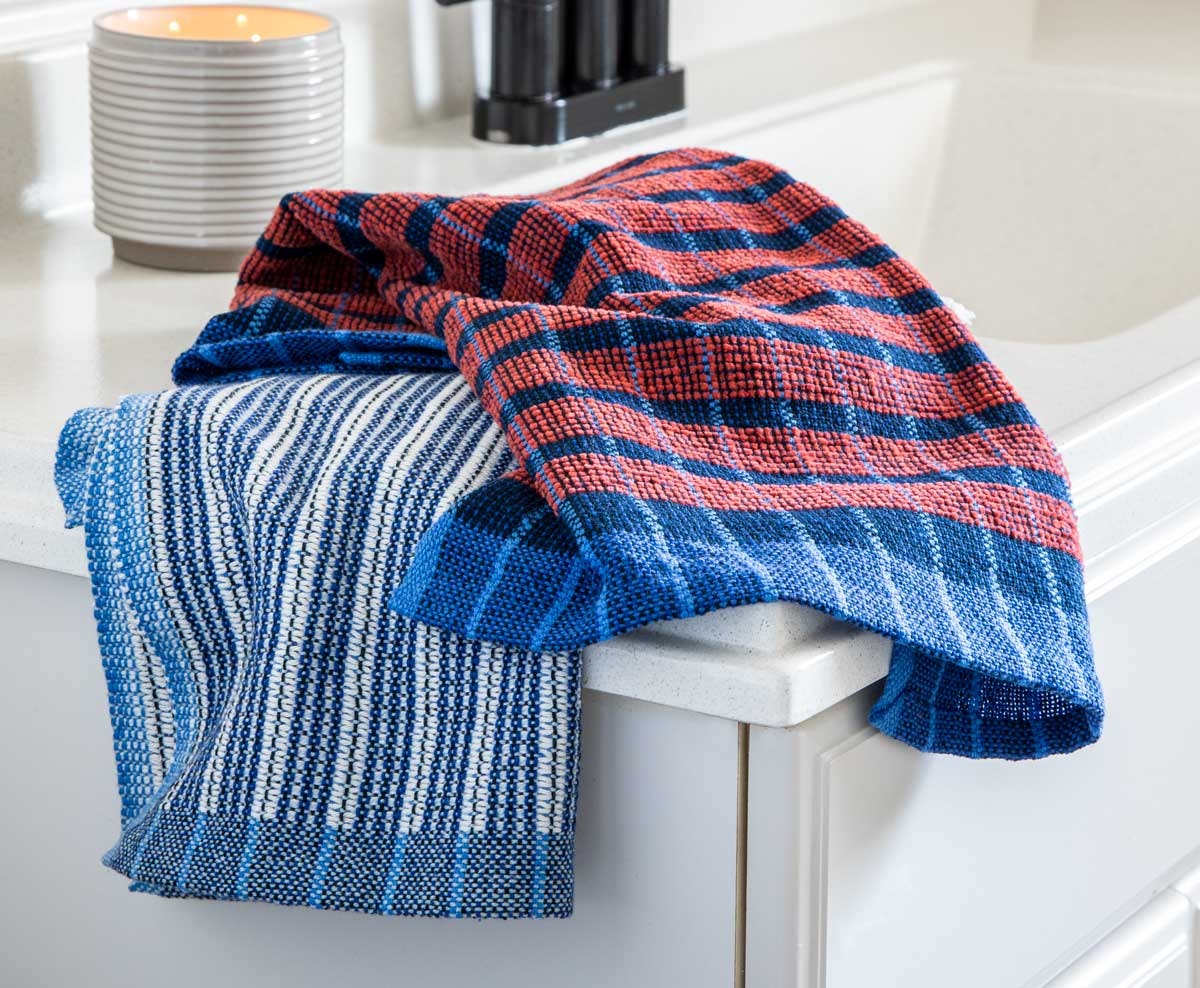Subscriber Exclusive
Design Challenge: Two Radically Different Towels on One Warp
Rather than weave duplicates, which she finds boring, the designer challenged herself to make the second towel very different from the first.
Rather than weave duplicates, which she finds boring, the designer challenged herself to make the second towel very different from the first. <a href="https://handwovenmagazine.com/be-our-guest-hand-towels/">Continue reading.</a>
https://handwovenmagazine.com/cdn-cgi/image/format=auto/https://www.datocms-assets.com/75077/1756503821-horiz_250410_hwfall25-121.jpg?auto=format&w=900
With this project, designer Jennifer E. Kwong set out to create two designs on the same warp that look completely different from each other, while working only from stash. Her plan was working beautifully—that is, until she ran into a problem with the second design. Luckily, she was sampling and was able to change course before it was too late. Read more about what happened and how she recovered, and get ready to weave one or both of these towels yourself. Please enjoy this subscriber bonus project from Handwoven Fall 2025.—Handwoven editors
About the Be Our Guest Hand Towels
The Fall 2025 issue’s color palette provided the perfect opportunity to experiment with a tube of rusty red chenille I’d found at a thrift store. I originally planned to weave a matching pair of towels, but I find it incredibly boring to weave duplicates.
SUBSCRIBER EXCLUSIVE
With this project, designer Jennifer E. Kwong set out to create two designs on the same warp that look completely different from each other, while working only from stash. Her plan was working beautifully—that is, until she ran into a problem with the second design. Luckily, she was sampling and was able to change course before it was too late. Read more about what happened and how she recovered, and get ready to weave one or both of these towels yourself. Please enjoy this subscriber bonus project from Handwoven Fall 2025.—Handwoven editors
About the Be Our Guest Hand Towels
The Fall 2025 issue’s color palette provided the perfect opportunity to experiment with a tube of rusty red chenille I’d found at a thrift store. I originally planned to weave a matching pair of towels, but I find it incredibly boring to weave duplicates. [PAYWALL] I much prefer to sample and play, so I set myself a challenge: Weave a second towel that looks radically different from the first, while sticking to the issue’s color palette and working only from my stash (no time for shopping!).
Deciding On the Second Design
Because the first design (in plain weave) used dark, saturated colors and dominant horizontal stripes, I decided that the second towel would use light, unsaturated colors and feature vertical stripes.
My first thought was to use supplemental warp ends to change the look of the existing warp stripes. I quickly talked myself out of that, due to laziness and not wanting to tension each warp individually. Instead, I settled on creating the illusion of vertical stripes using summer and winter with a dukagång treadling.
Where It Went Wrong
Though I had very little experience with chenille, I knew one potential hazard in using it was the possibility of worming. Chenille had worked well enough as plain-weave weft stripes in the first towel. For the second towel, I decided to use summer and winter because of its short floats, and I hoped a firm beat would compensate for the open sett.
 Although the Be Our Guest Hand Towels, designed by Jennifer E. Kwong, are woven on the same warp, the patterning of each is distinct.
Although the Be Our Guest Hand Towels, designed by Jennifer E. Kwong, are woven on the same warp, the patterning of each is distinct.
My washed sample disproved my hypothesis. The chenille wormed, probably because each float removed two interlacements, and the alternating picks of tabby weren’t enough to create a tight ground cloth. Oh well. This is why we sample!
Figuring Out Plan B
Instead of the chenille, I chose 8/4 cotton for the pattern weft in the second towel. I was worried the result might be too stiff, but combined with the open sett, it produced a thick yet flexible and absorbent fabric—perfect for a hand towel.
You can weave a matching pair of either version, or follow my lead and weave two towels from the same warp that look very different.
Weave it Yourself: Project Overview
STRUCTURE
Plain weave and summer and winter.
EQUIPMENT
4-shaft loom, 18" weaving width; 10- or 15-dent reed; 2 shuttles; 3 bobbins.
YARNS
Warp: 8/2 cotton (3,360 yd/lb; Maurice Brassard), #4272 Bleu, 185 yd; #5981 Navy and #963 Royal, 236 yd each.
Weft: Towel 1 (navy/red version): 8/2 cotton, #4272 Bleu, 42 yd; #5981 Navy, 132 yd. Cotton chenille (100% cotton; 1,450 yd/lb; Maurice Brassard), #CH5213 Cayenne, 56 yd.
Towel 2 (white/blue version): 8/2 cotton, #756 Bleu pâle, 224 yd. 8/4 cotton (1,680 yd/lb; Maurice Brassard), #101 Blanchi, 184 yd.
OTHER SUPPLIES
8/2 cotton scrap yarn in a contrasting color, 30 yd; sewing machine, washable clear school glue watered down to the consistency of heavy cream (and foam brush to apply it), or hair spray. Glue/hair spray will temporarily prevent raveling in lieu of sewing.
WARP LENGTH
258 ends (292 threads) 2¼ yd long (includes floating selvedges; allows 6" for take-up, 20" for loom waste).
SETTS
Warp: 15 epi (1/dent in a 15-dent reed or 1–2/dent in a 10-dent reed).
Weft: Towel 1: 16 ppi.
Towel 2: 18 ppi plain weave, 30 ppi pattern.
DIMENSIONS
Width in the reed: 173⁄10".
Woven length: (measured under tension on the loom) 54½".
Finished size: (after wet-finishing and hemming) two towels, 14½" × 23" each.
Weave it Yourself: Project PDF + WIF Link
Visit the Handwoven library to get the PDF and WIFs for the Be Our Guest Hand Towels.


 Although the Be Our Guest Hand Towels, designed by Jennifer E. Kwong, are woven on the same warp, the patterning of each is distinct.
Although the Be Our Guest Hand Towels, designed by Jennifer E. Kwong, are woven on the same warp, the patterning of each is distinct.